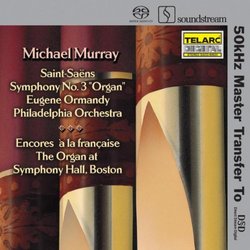| All Artists: Saint-Saens, Michael Murray, Eugene Ormandy, Philadelphia Orchestra Title: Saint-Saens Symphony No. 3 "Organ" / Encores a la Francaise / Ormandy, Murray, Philadelphia Orchestra (Stereo Hybrid SACD) Members Wishing: 0 Total Copies: 0 Label: Telarc Release Date: 7/27/2004 Album Type: Hybrid SACD - DSD Genres: Special Interest, Classical Styles: Opera & Classical Vocal, Historical Periods, Baroque (c.1600-1750), Symphonies Number of Discs: 1 SwapaCD Credits: 1 UPC: 089408063466 |
Search - Saint-Saens, Michael Murray, Eugene Ormandy :: Saint-Saens Symphony No. 3 "Organ" / Encores a la Francaise / Ormandy, Murray, Philadelphia Orchestra (Stereo Hybrid SACD)
CD Details |
CD ReviewsOrmandy & Philadelphia do Saint-Saens: A Classic of the reco Dan Fee | Berkeley, CA USA | 05/21/2007 (5 out of 5 stars) "If memory serves, Eugene Ormandy did the Saint-Saens Third Symphony several times in various recordings. Given the brilliant orchestration, plus the use of the great French pipe organ, this piece just has to be a show piece. It demonstrated vinyl LP stereo, then it demonstrated the early failed vinyl quad, then it demonstrated CD stereo, and now it arrives on SACD. This master tape was made in the transition years before superaudio surround sound actually arrived, yet it represented a sterling technical step forward, thanks to the 50 Hz soundstream system that allowed an increase in resolution and something closer to what fanatics have long called, tube-like warmth.
Now this soundstream master is successfully transferred into DSD superaudio, albeit limited to two stereo channels. Which just serves to demonstrate how very much can be accomplished in two channels, given the higher resolution that DSD procedures allow. Yes, the dynamic range and detail and sense of tonal presence are all remarkable and lovely. And if this doesn't approximate the holy grail of tube-like warmth, then I do not think we are ever going to get there via digital methods. Such technical capacities would mean little if this disc were not also showing off the rich sheen of the famed Philadelphia strings, christened with woodwinds in platinum, and golden glowing brass. The organ is particularly effective, yet integrated always into the larger orchestral fabric. Needless to say, there are never any problems of musical technique with the members of the Philadelphia. They excel, as a matter of course. Yet we must not take their excellence for granted, even though they are so generous with their talents that being cup bearer to the gods must come to seem for a while like the most ordinary of musical occupations. The Saint-Saens was recorded complete with organ, played by virtuoso Michael Murray, at the Saint Francis de Sales church in Philadelphia, so it has special claims to care and to adopting a clean, non-gimmicky approach. Nearby streets were actually closed to traffic during the sessions, and special voicing of the organ and the church as an acoustic recording venue were carried out. All of this effort paid off handsomely, now that we can hear what the original master captured. There is nothing eccentric in this performance. It is entirely mainstream in its tempos and accents. Ormandy was often under-rated, like Fritz Reiner ... competent, yes, but ... Hearing him again after all these years reveals the rock solid tempo management he could take for granted, as well as his ability to get out of the way of the music and let the composer ring through without mannerism or fuss. This is all to the good, since with a facile composer like Saint-Saens, it is easy to try to hitch things up a bit by plastering on somebody's version of Frenchification, gone usually all glitzy. The end results of such pushing and pulling is not only to maul and distort the music, but in the end to make the music seem even shallower and less substantial than ever. Ormandy does not let his players play down to the composer, nor does Michael Murray condescend, despite the composer's use of the organ for color and weight, as well as for display. The remainder of the SACD is a second complete French music organ recital, played solo by Michael Murray on the great organ installed in Boston's Symphony Hall. It is difficult to imagine an organist who could play this recital repertoire better, nor a better instrument upon which the music could be played. The famed acoustics of Symphony Hall add their hallowed luster. Murray as an organist is a masterful twin to Ormandy as band leader. Fuss, muss, and fiddle are foregone in favor of the organist adopting a direct, astute, and very rewarding transparency as a channel of musical communication. The tonal occupations of each different recital piece come through, clearly, and if we have to hear something after the symphony so grandly concludes, it is hard to gripe about this recital being it. Among the full-channel superaudio competition, I am favorably disposed to the Nezet-Seguin/Montreal Metro outing. It has its own special values. The recent recording by Eschenbach with Philadelphia is also getting loud raves, so that one is probably in the high running, too. Yet if you grew up with Ormandy - or if you didn't, and have been wondering just what the talk was all about during his long-standing tenure as music director - this disc is a blessedly welcome blast from the past. Bravo to Telarc for re-releasing it in superaudio, and not just consigning it to the past. Why just have one Saint-Saens' Third? Plus you can use the organ recital portion to help voice and balance your chosen subwoofer into the home system you have been dying to test. Sounds like a win-win-win, thanks to soundstream, and thanks to solid musical values." |


 Track Listings (11) - Disc #1
Track Listings (11) - Disc #1